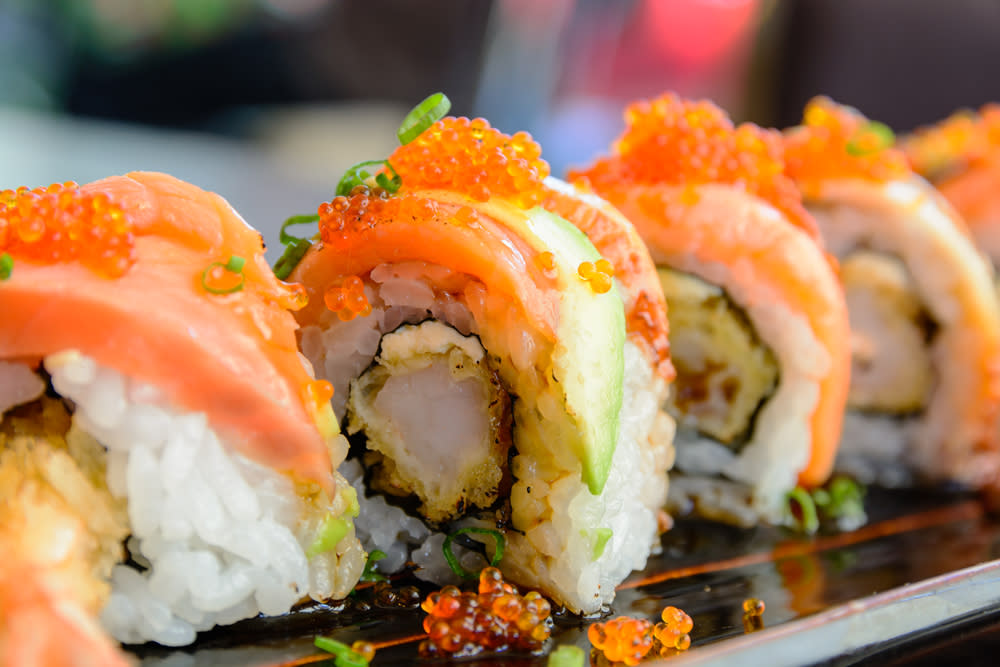Here’s how to know if your sushi is actually fresh
When it comes to things we can’t live without, delicious sushi is definitely in the top five. Seriously, if it were up to us, we’d be rocking sushi-prints and nail art 24/7 because the love is that real. And we’re sure many of you can appreciate some good sushi, too. But what constitutes “good sushi,” and how can you tell if your sushi is fresh?
For a lot of people sushi has become a quick go-to meal option — from tempura and teriyaki to sashimi, nigiri, and more deliciously complicated traditional dishes — you could probably say sushi has become completely mainstream. However, with a meal that is full of mostly raw fish and cold rice and is often found in pre-prepared boxes…things can get pretty questionable, pretty quickly.
And you can’t help wondering when your sushi was made and how fresh it really is!
The very last thing you want to eat is bad sushi. We know it’s not possible to completely avoid subpar sushi (things happen) but there are a few things you can check for to make sure your sushi dishes are at their freshest.
1. The smell
A post shared by lekeamib (@bimae_) on Jun 26, 2017 at 4:35am PDT
One good way to tell if your sushi is fresh is the smell. As in, there shouldn’t be one. Fresh fish should have no smell at all, and neither should the restaurant. A clean and odorless shop is always a good clue that the staff care about food safety and quality. But if there is a smell, world-famous sushi chef Hidekazu Tojo thinks, “a good sushi restaurant should smell like cucumber or watermelon.”
2. The look
A post shared by Sushi Love Forever (@sushiloveforever) on Jun 26, 2017 at 11:14am PDT
Take a second to check out the flesh of the fish. It should be shiny, translucent, and free from any milky slime. Dull looking, slimy fish are major signs your sushi is off. The whiteness of the rice and the crispness of the nori (seaweed) can also be indications of freshness (or lack thereof).
Also worth noting when it comes to tuna, sushi expert Trevor Corson says looks can be deceiving, as it is common practice in the industry to gas tuna with carbon monoxide to make it look pink. Which means the pinkness is by no means an indication of freshness. If the tuna looks like it is turning brown around the edges, you might want to opt for the vegetable roll.
3. The feel
A post shared by michelunardi (@michelunardi) on Jun 26, 2017 at 5:22pm PDT
The flesh of fresh fish should be firm enough to spring back when pressed. Be sure to check to see if your sushi meets this criteria before consuming.
4. The taste…
What taste? If your sushi didn’t pass the smell, look, feel tests…there is absolutely no way you should be tasting it! Unless food poisoning is your thing.
A post shared by Fernanda Delgado (@nanda__delgado) on Jun 26, 2017 at 5:31pm PDT
Additionally, if your sushi is pre-packaged be sure to check the expiration dates and don’t be afraid to ask the staff exactly when your meal was prepared.
A few other tips to make sure your sushi experience is the best you’ve ever had:
Get recommendations! Word of mouth or sites like Yelp tend to be great for weeding out the weaker restaurants and keep you from wasting your time. Also, many sushi experts recommend skipping Sundays since Japanese restaurants don’t always have fresh fish delivered on Sundays (and sometimes not even on Saturdays). Quality sushi restaurants are also usually closed on Mondays.
If you can, you should avoid all-you-can-eat sushi. While the “deal” might be tempting, you’ll probably end up regretting it. Sushi is supposed to be high quality so a lack of freshness could be the reason you’re getting massive amounts for just 10 bucks.
A post shared by in focus (@lifeisjourney___) on Jun 26, 2017 at 10:45pm PDT
And that’s how you can tell if your sushi is really fresh! Be sure to drop us a line if you find any great sushi spots worth checking out.


